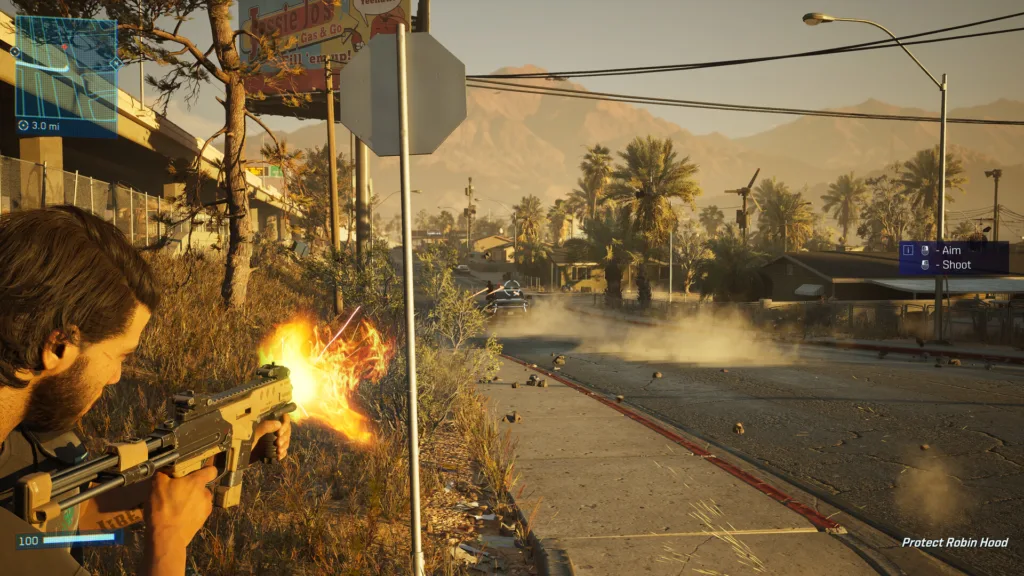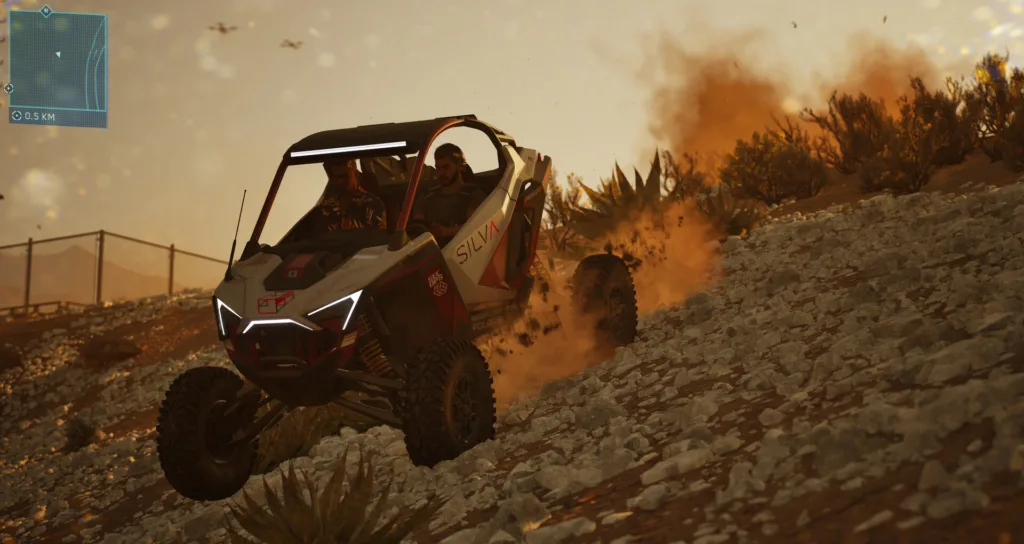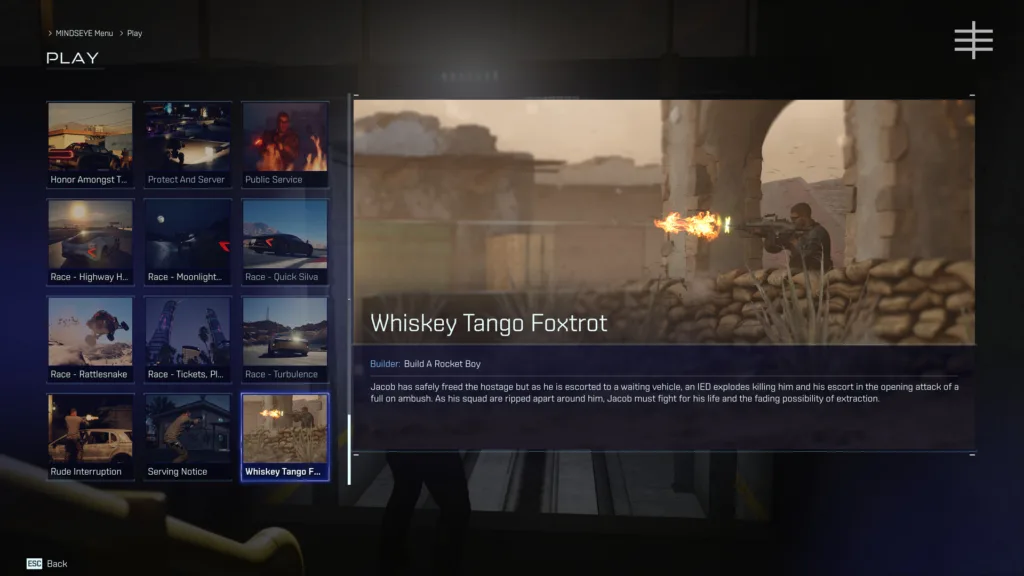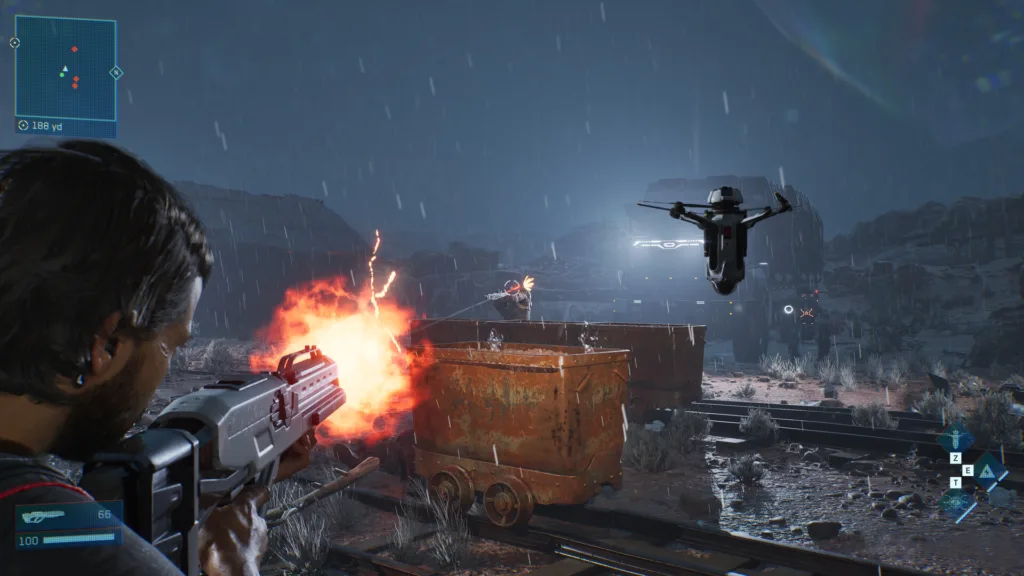Redrock rises from the desert floor like a circuit board, its streets glowing with neon advertisements and the cold, unblinking eyes of robotic sentinels. In the distance, a colossal sphere projects corporate propaganda onto the night sky, a constant reminder of who owns this city.
This is the world of MindsEye, a place that presents the shimmering promise of a high-tech thriller set in a corporate-run tomorrow. You are Jacob Diaz, a former soldier trying to piece together a life shattered by amnesia. The only clue to your past is a strange, powerful implant fused to your neck, a piece of technology created by the monolithic Silva Corporation.
To find answers, Jacob takes a security job within the company, descending into the heart of the beast. His personal search for identity quickly collides with a larger conflict of runaway AI and corporate malfeasance. The stage is set for a tense story of espionage and rebellion, pitting one man with a fractured memory against a seemingly invincible technological power. It is a classic setup, promising a look at a future where humanity’s own creations have become its gilded cage.
Skin-Deep Dystopia
At first glance, Redrock is a masterclass in grounded futurism. The art direction skillfully fuses the familiar architecture of today’s urban sprawl with the looming presence of advanced robotics and autonomous drones. This isn’t an alien future; it’s a disturbingly credible five-minutes-from-now, where sunlight glints off the metallic sheen of a parked jet with breathtaking realism and factory machinery operates on a colossal scale.
The vehicles are a particular triumph, projecting current design trends forward into a fleet of cars that feel both futuristic and entirely practical. For a time, the sheer visual integrity of the world is compelling. This city looks like a place with a story to tell.
But this visual splendor is a façade, an elaborate movie set waiting for actors who never arrive. Step off the prescribed narrative path, and the illusion shatters. Fire a weapon in a crowded street, and the citizens barely flinch. The all-seeing corporate police state is nowhere to be found. In a game about consequence, your actions in the world have none.
This isn’t a design choice to empower the player; it’s a symptom of a world that is not a system to be engaged with, but a backdrop to be driven past. Games like the Mafia series have long proven that a linear narrative can thrive within a beautifully realized city. The difference is that those cities felt inhabited. Redrock feels hollow. Try to explore its inviting vistas, and the game will scold you for straying, often triggering an instant mission failure. The world is a sprawling, gorgeous corridor that punishes you for trying to find a door.
The Illusion of Action
At its heart, MindsEye is a third-person cover shooter, but one that feels like a relic from a much earlier design era. The mechanics are functional in the most literal sense: you can aim, you can shoot, and you can hide behind waist-high walls. Yet, the entire system is devoid of the impact and strategic nuance that has defined the genre for over a decade.
Landing a shot delivers no satisfying feedback, and a perplexing lack of any melee attack leaves you feeling strangely helpless if an enemy closes the distance. New weapons simply appear in your inventory with no fanfare, their tactical purpose unclear in a system where one assault rifle feels much like another. This isn’t a combat system; it’s a passable imitation of one.
This lack of depth is compounded by enemy AI that feels years out of date. Foes either stick rigidly to cover or charge with baffling abandon, their behavior so predictable that encounters devolve into a simple, repetitive shooting gallery. While games like The Division 2 build tension through flanking maneuvers and coordinated enemy tactics, MindsEye‘s opponents feel like animatronics on a fixed track. This is only worsened by technical jank, where a wounded soldier might teleport back into cover, shattering any sense of physical presence.
The one spark of a compelling idea comes from Jacob’s drone companion. In the late game, its abilities evolve beyond simple reconnaissance, allowing you to turn enemy robots against their masters or call in devastating grenade strikes. For a moment, a flicker of tactical creativity appears. But this spark is quickly extinguished by poor balancing; the drone’s attacks become so effective that they render direct engagement obsolete, transforming challenging firefights into a remote-controlled turkey shoot.
This pattern of restrictive design infects the entire mission structure, which settles into a monotonous loop: drive to a location, watch a non-interactive cutscene, shoot a wave of enemies, and repeat. There is no room for improvisation. The game consistently denies you agency, forcing you to play through a tedious CPR minigame that should have been a cinematic, while relegating a potentially thrilling highway chase against high-speed robots to something you can only watch. It constantly shows you the exciting game it could have been, then forces you to play something else entirely.
On The Road to Nowhere
Here lies the most baffling contradiction in MindsEye. For a game that gets so much wrong, its driving model is surprisingly right. The vehicles have a satisfying sense of weight and presence on the road. Whipping a futuristic sedan into a high-speed handbrake turn feels responsive and cinematic, avoiding the floaty or overly magnetic handling that plagues many action games. The physics react convincingly to burst tires, adding a layer of dynamic challenge to a chase. In these moments, the game feels fantastic. It has a mechanical soul.
But this excellent driving system is trapped within a design that actively works against it. The expansive map is used not for exploration, but for long, mandatory commutes between objectives. These five-minute drives are spent in near silence, with no radio stations or musical score to fill the void.
Their sole purpose is to serve as a container for expositional phone calls, turning traversal into a thinly veiled loading screen. This tedious padding is made worse by a set of inexplicable restrictions. In a world brimming with beautifully designed cars, you are forbidden from driving any vehicle other than the one assigned for your current mission.
You cannot steal a car. You cannot even enter a parked one. The foundational loop of this genre—seeing a cool car and taking it—is completely absent. Destroying your assigned vehicle results in an instant mission failure, a punitive system that cements the world not as a playground, but as a rigid and unforgiving path.
The Unfinished Script
When MindsEye wrests control away from you, it transforms into a stunning piece of cinema. The cutscenes are executed with a startling level of polish, featuring dynamic camera work and some of the most detailed character models and lifelike facial animations seen in recent years.
This visual fidelity is anchored by a genuinely superb vocal cast, led by Alex Hernandez as the protagonist, Jacob Diaz. Hernandez infuses Jacob with a gritty, grounded intensity that carries the story’s emotional weight, making you invest in his search for truth even when the gameplay falters. He makes you care.
That investment is precisely what makes the narrative’s collapse so profoundly disappointing. The initial premise is compelling—an amnesiac soldier, a mysterious implant, and a corporate conspiracy—and for a few hours, the plot builds a respectable momentum. But the pacing is erratic, and the story concludes not with a bang, or even a whimper, but with the screeching halt of a train hitting a deleted track.
This isn’t an artistic cliffhanger designed to spark debate; it is an abandonment. Major plot threads are left dangling, crucial questions go unanswered, and the resolution feels completely unearned. It’s a colossal anticlimax that leaves you feeling more confused than intrigued. To add a final layer of frustration, these cinematics are unskippable, forcing you to re-watch a story you already know leads absolutely nowhere.
System Shock
Beneath the impressive art direction, MindsEye is built upon a deeply unstable technical foundation. The visual quality seen in carefully curated trailers dissolves during actual play, plagued by severe performance problems across all platforms.
On console, the game struggles to maintain its 30 frames-per-second cap, frequently plummeting to slideshow-like levels during firefights. Even on high-end PC hardware, the experience is far from smooth, with persistent stuttering, choppy camera pans, and jarring frame hangs that turn chaotic car chases into nearly unplayable struggles. The issue is not a lack of power, but a profound lack of optimization.
This unstable performance actively sabotages the game’s aesthetic strengths. A persistent blurriness often obscures the detailed environments, making the world look muddy and indistinct, while distracting visual bugs like character ghosting in cutscenes and object pop-in are common. Beyond simple frame rates, the game is riddled with a general lack of polish.
You will encounter everything from amusing AI traffic pile-ups to game-breaking crashes that halt progress entirely. These are not minor blemishes on an otherwise solid experience; they are fundamental cracks in the structure. The overwhelming impression is that of a game released long before it was ready for public view.
An Empty Sandbox
Once the abrupt credits finish, MindsEye deposits you back into its world, but it’s a bizarre and empty homecoming. You are no longer Jacob Diaz. Instead, you inhabit a random avatar with no explanation, no new objectives, and no purpose. This “free roam” mode is a shell.
The drone abilities that offered the campaign’s only spark of tactical creativity are gone, and the world is just as restrictive as before. You still cannot interact with the vast majority of vehicles. The only activities are a few map icons that trigger the same bland combat encounters, stripped of any narrative context. It is not an endgame; it is a void, a clear indication of a feature that was simply not finished.
Buried within this aimless mode, however, is the game’s user-generated content suite. The creation tools are surprisingly deep, offering a complex interface for building custom missions. There is real potential here for a dedicated creator to design interesting scenarios. But a creative platform requires an engaged community, and a community requires a compelling core game to rally around.
The “Play” missions are brief, context-free, and offer no progression or rewards, failing to showcase the toolset’s potential. Ultimately, a powerful creation engine cannot fix a weak foundation. MindsEye provides a sandbox with sophisticated tools, but its shallow gameplay offers no reason for anyone to stick around and start building.
The Review
MindsEye
MindsEye presents itself as a next-generation blockbuster, and in its stunning cinematics and superb driving mechanics, you can see the ghost of a great game. However, this beautiful chrome shell is hollow. The experience is critically undermined by dated and restrictive gameplay, severe performance issues, and an incomplete story that collapses at the finish line. It is a textbook case of style over substance, a gorgeous world that is ultimately not ready to be played.
PROS
- Visually impressive world and high-quality cutscenes.
- Excellent voice acting, particularly from the lead.
- Satisfying and responsive vehicle handling.
CONS
- Shallow, repetitive combat and poor enemy AI.
- Severe performance problems and numerous bugs.
- A lifeless open world with nothing to do.
- Abrupt and deeply unsatisfying story conclusion.
- Restrictive mission design that punishes exploration.




















































